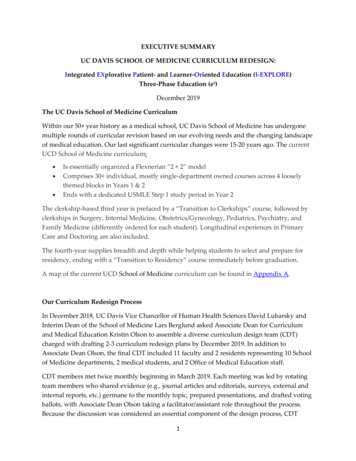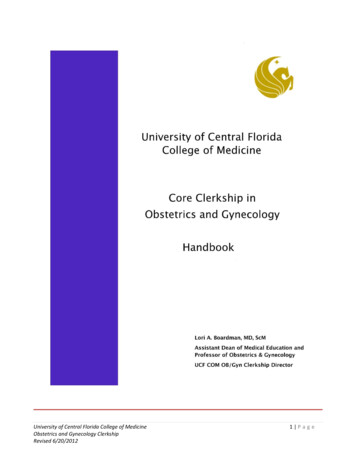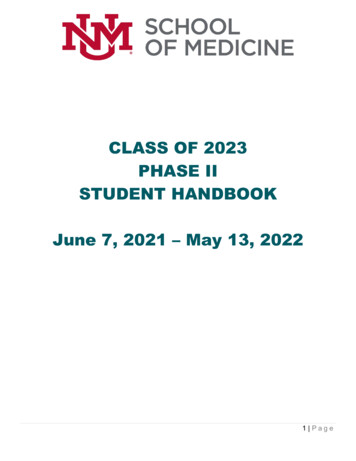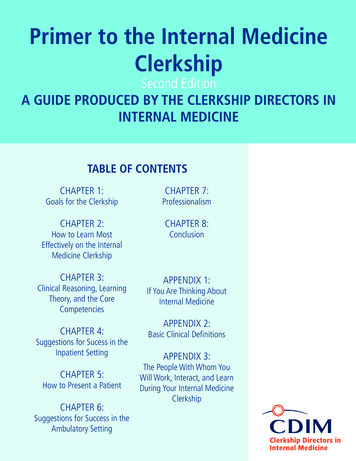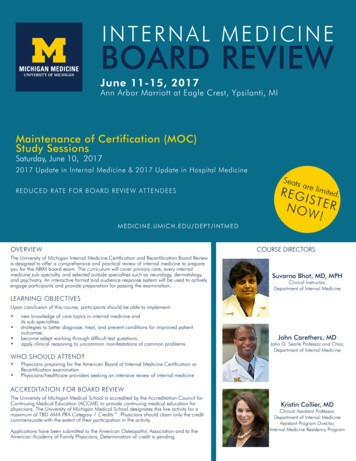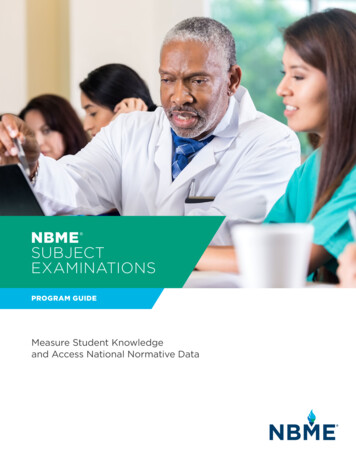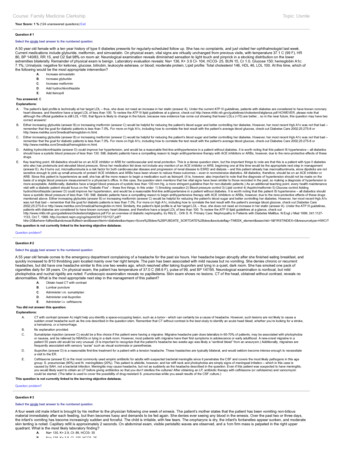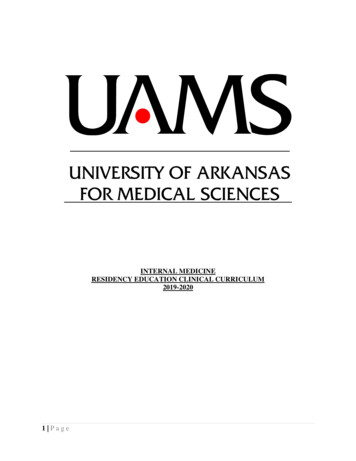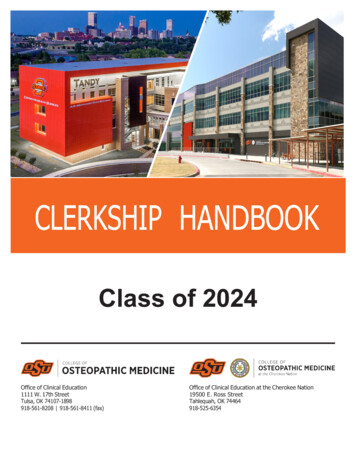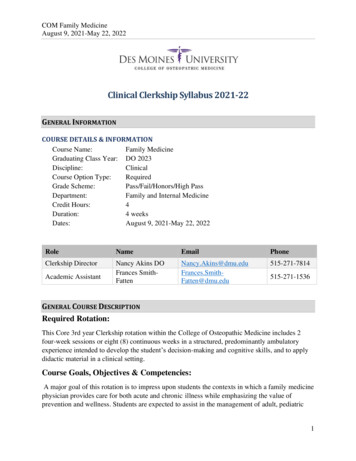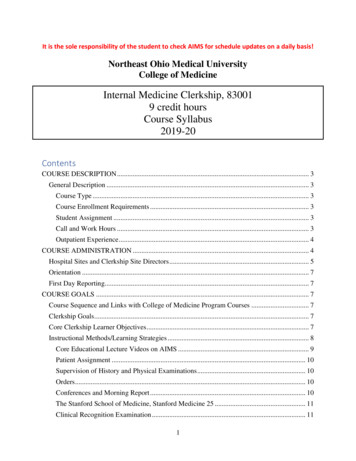
Transcription
It is the sole responsibility of the student to check AIMS for schedule updates on a daily basis!Northeast Ohio Medical UniversityCollege of MedicineInternal Medicine Clerkship, 830019 credit hoursCourse Syllabus2019-20ContentsCOURSE DESCRIPTION . 3General Description . 3Course Type . 3Course Enrollment Requirements . 3Student Assignment . 3Call and Work Hours . 3Outpatient Experience . 4COURSE ADMINISTRATION . 4Hospital Sites and Clerkship Site Directors . 5Orientation . 7First Day Reporting. 7COURSE GOALS . 7Course Sequence and Links with College of Medicine Program Courses . 7Clerkship Goals . 7Core Clerkship Learner Objectives . 7Instructional Methods/Learning Strategies . 8Core Educational Lecture Videos on AIMS . 9Patient Assignment . 10Supervision of History and Physical Examinations . 10Orders . 10Conferences and Morning Report . 10The Stanford School of Medicine, Stanford Medicine 25 . 11Clinical Recognition Examination . 111
Low Resource Clinical Skills. 11Palliative Care and Hospice Module. 11Aquifer Internal Medicine Online Modules . 12COURSE GRADE . 14Final Grade Determination . 14Formative, Mid-course, and End of Rotation Feedback . 15Clinical Skills Experience Portfolio (CSEP) . 15PASSPORT (IM Clerkship – Clinical Participation). 16Narrative Feedback . 16Internal Medicine NBME Practice Subject Examination . 16Course Remediation . 16COURSE TEXTBOOKS AND INSTRUCTIONAL RESOURCES . 17Required Textbooks and Resources . 17Recommended Textbooks and Resources . 17COURSE POLICIES . 17APPENDICES . 18Appendix A. History and Physical Examination Outline . 18Appendix B. Admission Orders Mnemonic Outline. 20Appendix C. The Stanford Medicine 25 . 21Appendix D. Internal Medicine CSEP . 222
COURSE DESCRIPTIONGeneral DescriptionThe Northeast Ohio Medical University M3 Internal Medicine Clerkship is a nine-week clinicalrotation. This core curriculum is designed to develop clinical competence, to foster appropriateattitudes toward professional responsibility as a physician and to introduce the student to thespecialty of Internal Medicine. The emphasis will be on the internist's method and approach tothe care of the patient. Both cognitive and non-cognitive learning will be primarily patientoriented.Course TypeThis course is solely a College of Medicine Course for M3 students taking place at medicalfacilities under the supervision of clinical site supervisors and their designated staff.Course Enrollment RequirementsSuccessful completion of M1 and M2 years of study.TrainingsHIPPABLSOSHAACLSResponsible Conduct ofResearchHuman Subjects ResearchScreeningsCriminal BackgroundCheckToxicology ScreenTB TestImmunizationsHepatitis B, MMR, Tdap,Varicella (requiredupon matriculation)Flu shotStudent AssignmentStudents are assigned to one of the ten hospital sites. All sites offer the benefits of a majorteaching center with outstanding attending faculty. The clerkship teaching sites are commonlybound by shared learning objectives as well as a common didactic and clinical curriculum.Teaching sites are closely monitored to ensure comparability. The depth and scope of clinicalencounters during the nine-week clerkship are comparable among sites as evidenced by studentfeedback, clerkship valuations and NBME subject examination scores.Call and Work HoursStudents will be assigned to a total of five (5) to ten (10) evening, overnight, night float or weekend calls during the clerkship. Students are not expected to be assigned call on Sundays duringthe day. Students are generally expected to work a part day on Saturdays but are not assignedduty on Sundays. Students may be assigned floor call or unit call. The student will be under thesupervision of residents or faculty while on call. On-call facilities will be provided by theassigned hospital. Students are not to be placed on call the night before CSAs or the NationalBoard subject exam. In compliance with guidelines established by the Liaison Committee onMedical Education (LCME), students generally will not be required to work longer hours thanresidents.3
Outpatient ExperienceStudents will be assigned on an individual basis to complete an outpatient ambulatory careexperience. At the discretion of the Clerkship Site Director, this might include a two-week blockof time or periodic time spent in a primary care preceptor’s office or primary care outpatientclinic(s).The ambulatory medicine experience will provide exposure to ambulatory patients, some ofwhom will be complex, and will allow the student to: Develop expertise in the techniques of the medical interview and physical examination,with particular emphasis on the focused evaluation in addition to the complete historyand physical. Acquire basic factual information with respect to pathophysiology and differentialdiagnoses of common medical problems as well as opportunities for health maintenanceand illness prevention. Recognize and understand the role of psychological, social and economic factors in thediagnosis and treatment of each patient's illness. Develop basic skills in medical decision making, including planning the workup, usinglaboratory tests effectively, treating common medical emergencies and developing soundclinical judgment. Acquire a sense of the physician's professional role and attitude of concern andresponsibility for patients. Develop a more realistic view of primary care internal medicine practice and of thevaried structures of health care. Further develop learning skills, including problem solving, group process, independentstudy and use of the literature. Establish close, long-term relationships with faculty, who can serve as role models.Each student will be evaluated by his or her preceptor using the standard clerkship assessmentform. The preceptor will forward the assessment to the Clerkship Site Director for inclusionwhen determining the student's final grade. Students are required to record all patients observedor examined during the experience in their CSEP.COURSE ADMINISTRATIONDr. Paul Lecat serves as the Clinical Experiential Director for the Internal Medicine Clerkshipand in collaboration with Dr. David Sperling, Senior Director of Clinical Experiential Learning,and Dr. Susan Nofziger, Director of M3 Clinical Experiences, provides oversight for theclerkship. In his role as Clinical Experiential Director, Dr. Lecat ensures that implementation ofthe Internal Medicine curriculum is comparable across all teaching sites.4
Paul J. Lecat, M.D.plecat@neomed.edu330.325.6843David Sperling, M.D.dsperling@neomed.edu330.325.6778Susan Nofziger, M.D.snofziger@neomed.edu330.325.6582Course CoordinatorDavid Ruble, M.S.Email: druble@neomed.edu330.325.6140Hospital Sites and Clerkship Site DirectorsThe facilities for clinical instruction in Internal Medicine are those institutions and residencytraining programs that have committed themselves to the Northeast Ohio Medical UniversityCollege of Medicine for participation in the undergraduate training of the NEOMED students.Site Directors are designated at each hospital that provides a clerkship experience.Responsibilities of the Clerkship Site Director include tasks and responsibilities in threecategories: 1) curricular, 2) assessment and 3) administrative.Kevin C. Frey, M.D.Aultman Hospital andMercy Medical Center(Canton)Tom Tanphaichitr, MDCleveland Clinic AkronGeneral5Denis R. Lunne, M.D.Mercy HealthSt. Elizabeth YoungstownHospital
Rawan Narwal, M.D.Mercy Health, St. VincentMedical Center (Toledo)Jeffery M. Becker, M.D.MetroHealth System(Cleveland)David Sypert, D.ORiverside Methodist Hospital(Columbus)Thomas Boes, M.D.Riverside Methodist Hospital Hasan Abuamsha, M.D.St. Vincent Charity Medical(Columbus)Center (Cleveland)Bradley A. Moore, Jr., M.D.Summa Health System,Akron City HospitalPaul Watanakunakorn, MDTrumbull Regional MedicalCenter6Binay C Eapen, MDMount Carmel Health System(Columbus)Todd Lisy, MDWestern Reserve Hospital
OrientationThe clerkship begins with orientation focusing on clerkship goals and objectives, studentresponsibilities, schedules and assessment methods. Students will be provided information aboutrelevant hospital policies and procedures, personnel contact information, meal allowances (ifprovided) and parking. The orientation will include instruction on the risks of infection,techniques for reducing the spread of infection and site-specific hospital protocol to be followedin the event of exposure to an infectious or environment hazard or other injury.First Day ReportingFirst day reporting information varies by clinical site. Please see the AIMS M3 site for first dayreporting information.COURSE GOALSCourse Sequence and Links with College of Medicine Program CoursesThis course immerses students in the clinical setting after their first two foundational years ofmedical education. This course introduces students to multiple medical disciplines in the clinicaland simulated setting which prepares them for selecting electives in their M4 year.Clerkship GoalsThe overall goal of the Internal Medicine Clerkship is the mastery of the basic core competenciesthat are essential for practice as a competent physician focused on the ACGME corecompetencies. The Internal Medicine Clerkship will focus on these competencies in the contextof the delivery of care of adult patients in internal medicine. The overall desired end point is themastery of basic core competencies that are essential for practice as a competent physician,regardless of career focus to include: Acquisition of a body of knowledge and skills necessary for the recognition andmanagement of patients with common medical diseases and disorders and for theprovision of good patient care, Refinement of history-taking and physical examination skills and development ofdiagnostic decision-making skills, Development of an evidenced-based approach to the evaluation, management and care ofpatients, Commitment to ethical principles and behaviors that promote effective patient andprofessional relationships, including honesty, integrity, reliability and compassion, Recognition of the constantly evolving nature of knowledge and the value of intellectualcuriosity and lifelong learning, Exploration of preventive medicine and psycho-social-environmental factors that directlyinfluence disease and promote better patient outcomes, Recognition and appreciation of one’s own limits, values and need for growth as well asrecognition of one’s own response to criticism, and Development of personal characteristics including professional appearance andappropriate balance between one’s personal and professional life.Core Clerkship Learner ObjectivesUpon completion of the nine-week Internal Medicine Clerkship the student will be able to:7
Obtain a thorough history and perform an appropriate physical examination in a timeefficient manner. Present clinical data in both written and oral form in a clear and cogent fashion. Synthesize data in order to be able to generate a pertinent problem list and relevantdifferential diagnoses for each identified problem. Develop a diagnostic plan to differentiate rationally between possible diagnoses. Perform routine technical procedures commonly required on an internal medicine service. Interpret diagnostic tests and perform laboratory procedures effectively to confirm orclarify a diagnosis. Discuss the cost and utility of specific laboratory tests. Construct a management plan reflecting an understanding of physiology andpharmacologic principles with the goal of optimizing the patient's ultimate well-being. Establish effective communication with patients, patients’ families and colleagues. Respect and support the patient’s autonomy, individuality and right to privacy,confidentiality, dignity and quality of life, and freedom from undue discomfort or injury. Recognize ethical dilemmas and avoid conflict between one’s own ethical beliefs andchoices made by patients and their families. Identify appropriate consultation resources, both medial and non-medical, as well ascommunity resources. Recognize awareness of his/her own feelings as a medical student and the patient'sfeelings about illness. Recognize the importance of cost-effective health care, quality assurance and practiceguidelines in today’s health care market, and recognize one’s role as an advocate foraccess to health care for all patients. Function comfortably within the hospital or outpatient setting working as a team memberwith faculty, peers, ancillary personnel and other health care professionals. Recognize potential medico-legal issues.Instructional Methods/Learning StrategiesA variety of learning strategies will be used during the clerkship to help you achieve your goals.Strategies include but are not limited to: Patient encounters (inpatient, private office, clinics, hospice centers) Core educational lecture videos Small group discussions Conferences, morning report and teaching rounds American College of Physicians Internal Medicine Essentials for Students American College of Physicians MKSAP for Students 5 Practice-based Learning and Improvement Project (PBLI) TextbooksOrganized reading and study materials will be available to support learning about assignedsubjects, problems of assigned patients and to prepare for comprehensive written examinations.This source material will include enumeration of concepts to be learned and specific detailspertinent to these concepts. These materials will be supplemented by conferences and lectures,which may include EKG, CXR, ABG interpretation sessions and by selective patientassignments appropriate to the curriculum plan.8
The net effect of the several avenues of implementation is to provide a framework designed tohelp the student acquire the knowledge of selected internal medicine subjects, to appreciate thepathophysiology involved, to use the scientific method of problem solving, to developproficiency in selected basic skill and to develop a professional attitude of responsibility andempathy toward patients. A significant advantage of this overall approach is early developmentof the capabilities and habits which will support each medical student in a life-long study ofmedicine.Core Educational Lecture Videos on AIMSIn order to broaden the student’s knowledge and understanding of the scope of internal medicine,a core lecture video series has been developed by the faculty that includes common topics in bothgeneral internal medicine as well as the specialties and subspecialties. As proactive learners,students are encouraged to set a timetable for viewing the lectures during the course of theclerkship. The lectures are intended to help students gain insight into the practice of internalmedicine and to prepare for their CSA and National Board subject examination. To access thelecture video series, click on Core Educational Lecture Videos under the M3 Clerkships AIMSSite.Core Educational Lecture VideosCardiac DiseaseChest PainHeart FailureInternal Medicine EKG BasicsMaking a Dermatologic DiagnosisNarration of Infectious Disease SlidesNutrition and Hydration at the End of Life: Living withDying Hospice Patients as TeachersPain Management: Living with Dying Hospice Patientsas TeachersPalliative Care: Basic Symptom Management I –Pain Assessment and ManagementPalliative Care: Basic Symptom Management II –Nausea, Vomiting, Dyspnea and DeliriumPractice-Based Learning and Improvement ProjectPrevention, Detection and Management of COPDThe Epidemiology of Death and Dying: Living withDying Hospice Patient as TeachersVasculitis9John C. Cardone, M.D.J. Ronald Mikolich, M.D.George I. Litman, M.D.George I. Litman, M.D.Robert T. Brodell, M.D.William G. Gardner, M.D.Kevin F. Dieter, M.D.Kevin F. Dieter, M.D.Steven M. Radwany, M.D.Steven M. Radwany, M.D.John D. Sutton, M.D.Timothy J. Barreiro, D.O.Kevin F. Dieter, M.D.Elaine M. Greifenstein, M.D.
Patient AssignmentStudents are to be assigned an average of three new patients per week. The supervising resident,with the guidance of the Clerkship Site Director and chief resident will be responsible forselecting the patients seen by the student and ensuring an appropriate mix. The student’s CSEPshould be reviewed periodically by the Clerkship Site Director and supervising resident to ensurethat the student is seeing a proper number and mixture of patients. The type and volume ofpatients should be adjusted on an ongoing basis, as appropriate.A complete history-taking and physical examination is to be performed and a written reportpromptly completed on every new patient who the student will actively follow in the hospitalduring the clerkship.Students are required to complete and submit for critical review a minimum of six (6) history andphysical examinations and two (2) formal SOAP Notes spaced out over the nine-week clerkship.Students should expect to receive timely (as is feasible) feedback, thus allowing them to respondto and incorporate the feedback when completing subsequent histories and physicals. Thisprocess enables the Clerkship Site Director to assess students’ progress in developing andrefining their skills.All of the student's written patient reports are to be reviewed by the supervising resident,cosigned and then may be entered into the patient's chart. The protocol for reviewing thestudents’ written histories and physicals will vary by site.Supervision of History and Physical ExaminationsWithin the first two weeks, two history and physical examinations should be done with theresident or attending physician. If the student is then felt to be capable, subsequent interviewsmay be conducted alone. "Double teaming" (resident and student) a newly admitted patient on anoccasional basis is encouraged as it facilitates exchange between the resident and the student atthe bedside. This should not be done routinely. The student should be observed taking a historyand performing a physical examination periodically during the nine weeks. An outline for thehistory and physical examination is contained in Appendix A.OrdersIt is anticipated that early in the rotation orders will be written frequently by the resident.However, it is expected that students will assume an increasing amount of this responsibility,such that toward the end of the clerkship most orders will be written by the student with theresident's co-signature. An outline for writing admission orders is contained in Appendix B.Conferences and Morning ReportStudents are required to attend morning report and formal teaching conferences along with thehouse staff and attending physicians. Clerkship Site Director’s teaching conferences, which cantake the form of basic lectures, physical diagnosis rounds, or other teaching activities, will be inaddition to formal teaching conferences.10
The Stanford School of Medicine, Stanford Medicine 25 website has very high quality videosdetailing physical examinations. Students may find these videos very useful and practical forreview. A link to this site along with a listing of the videos is contained in Appendix C.Clinical Recognition ExaminationWhile on the clerkship, students are expected to demonstrate the ability to solve clinicalproblems through interpretation of physical examination findings, procedural skill findings andlaboratory results. Topics covered on the exam will include basic physical findings, ECG, andradiology findings.The student’s ability to master these skills will be assessed via a PowerPoint image examination.Students will be asked to demonstrate their knowledge of the primary relationship of ten (10)selected images in diagnostic application. The examination will be administered at theNEOMED Rootstown Campus on the last day of the clerkship immediately preceding theNational Board subject examination or at the hospital site in Toledo and Columbus. The slideexamination is pass/fail with a minimum passing score of 70% (7 out of 10 slides). Any studentwho does not achieve a passing score will receive a score of “Below Expectations” on theFinal Grade Report Form in the competency of Patient Care, learning objective “Ordersand interprets diagnostic tests.” Students have come close to losing “clinical honors”because they performed poorly on this exam.Low Resource Clinical SkillsIn an effort to assist students in acquiring clinical skills, three slide sets containing blood smears,gram stains and urinalysis along with a narrative video have been developed by the faculty andare available on AIMS. There is also a sample quiz on the images. This is not required materialand is provided for your interest.Palliative Care and Hospice ModuleStudents will participate in a group discussion focused on the basic principles of palliative andhospice care. In preparation for the discussion, students are required to review the Primer ofPalliative Care (available at each site), and companion workbook, and to prepare responses to thequestions contained in the workbook (workbook is posted on AIMS M3 Clerkships Site in IMClerkship folder).Upon completion of the session, the student will be able to: Describe the differences between palliative and hospice care. List the most common physical problems to be assessed and planned for in caring for theseriously ill or terminally ill patient. Identify pain syndromes and recognize the challenges to providing effective pain controlfor the seriously ill or terminally ill patient. Outline a plan for effective symptom management. Establish a framework for communicating with seriously or terminally ill patients andtheir families. Demonstrate respect for and support the patient’s autonomy, individuality and right toprivacy, confidentiality, dignity, and quality of life and freedom from undue discomfortor injury.11
Recognize ethical dilemmas and avoid conflict between one’s own ethical beliefs andchoices made by patient and their families.Aquifer Internal Medicine Online ModulesInternal Medicine modules are intended to be a transition from didactic presentation ofinformation to the self-directed learning format students will need to develop and follow in alifelong study of medicine.Students must complete a total of 18 Internal Medicine cases by the end of the clerkship. Duringthe first week of the clerkship, students are required to select one case to complete and discussas a group with the other students at the assigned clerkship site. This is to introduce them to theInternal Medicine Cases (would need to be submitted individually to obtain credit).Students are required to select and complete at least 13 Internal Medicine cases IN ADDITIONTO the following required cases: Internal Medicine case 5 (fatigue) Internal Medicine case 20 (HIV) Internal Medicine case 30 (DVT) Pediatrics case 16 (DM1/DKA) Culture in health case 1 (Seizure disorder) Any cases needed to gain familiarity with all diagnoses listed in the “Diagnoses” sectionof the CSEP.Aquifer Internal Medicine Online Cases1 – chest pain2 – episodic chestdiscomfort3 – syncope4 – shortness of breath andleg swelling5 – fatigue (man)6 – hypertension7 – lightheadedness8 – type 2 diabetes10 – diarrhea and dizziness11 – abnormal LFTs13 – annual physical14 – pre-college physical16 – obesity17 – rash19 – anemia20 – HIV22 – cough and fatigue23 – fatigue (woman)25 – hospitalized withconfusion28 – shortness of breath andleg swelling9 – upper abdominal painand vomiting12 – lower abdominal pain15 – cough and nasalcongestion18 – memory problems21 – fever, lethargy andanorexia24 – headache, vomiting andfever26 – altered mental status27 – back pain29 – fever and chills30 – left leg swelling12
31 – knee pain34 – acute low back pain32 – joint pain35 – three-week fever33 – confusion36 – ascitesAquifer Registration and Log-in InstructionsFollowing are the instructions to gain access to the cases for first time users*:1. Go to: https://www.meduapp.com/users/sign in2. Enter your institutional e-mail under “Need to Register?” option3. Click “Register” button.4. An email will be sent to you. Follow the instructions in the email to set up your account.*You only need to register once with Aquifer to access Family Medicine, Internal Medicine,Pediatrics and Surgery (WISE-MD) modules. Separate registration is not required.13
COURSE GRADEFinal Grade DeterminationAssignment/AssessmentFinal Grade ReportForm Patient Care Interpersonal andCommunicationSkills Knowledge forPractice Practice-BasedLearning andImprovement Systems-BasedPractice Professionalism InterprofessionalCollaboration Personal andProfessionalDevelopment% ofFinalGrade50%Grade CriteriaType ofFeedbackSee overallClerkships CourseGuide including(1) behavioralanchors for eachrating in eachcompetencyelement and (2)the formula forfinal rating/gradeRubric withNarrativeFeedbackDateScheduled/DueFeedback isrecordedthroughout theclerkship viastudentevaluationforms. TheClinical Gradewill begenerated at theconclusion ofthe course bythe clerkshipsite directorsubmitted to forfinal reviewand gradeassignment tothe ClinicalExperienceDirector.Mid-course andend of rotationmeeting withSite DirectorClinical SkillsExperience Portfolio(CSEP)0%SatisfactorycompletionChecklist ofrequiredactivitiesNational Board ofMedical Examiners(NBME) subject exam50%Fail 58; Pass 5980; Pass withCommendation 81NumericalLast Friday ofscore and Fail, the coursePass or PasswithCommendationTotal CourseN/APractice-Based Learning and Improvement (PBLI) Project14
Students are required to complete a self-directed Practice-based Learning andImprovement (PBLI) Project specific to each clerkship (except Emergency Medicine). PBLIis important because physicians should monitor the quality of their own work, improvetheir work and keep up with developments in medicine. PBLI is based on the belief thatphysicians should be leaders in making change rather than reacting to changes made byothers and the belief that positive changes in one’s own practice behavior can have positiveeffects on large systems. Specific examples include: increasing preventive care, improvingchr
6 Rawan Narwal, M.D. Mercy Health, St. Vincent Medical Center (Toledo) Jeffery M. Becker, M.D. MetroHealth System (Cleveland) Binay C Eapen, MD
